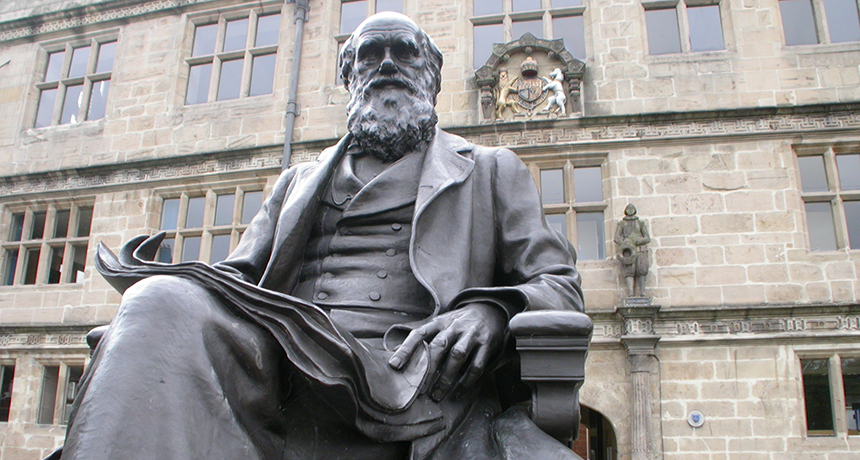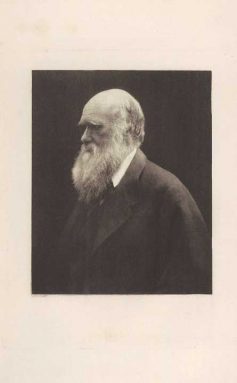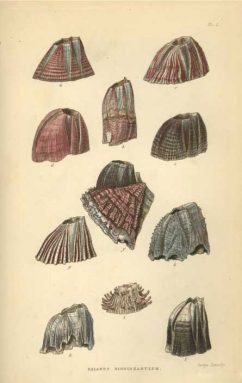The man who rocked biology to its core
Two hundred years later, Charles Darwin's ideas still live on

Charles Darwin, depicted in this statue, was a leading proponent of the idea that species will change over time to adapt to their conditions. Those species that don’t will eventually die out.
DAN_WRENCH/ISTOCKPHOTO

When the baby Charles Darwin arrived in the world, on February 12, 1809, modern science was also an infant. Chemists had begun talking about things called atoms. But nobody knew what atoms really were. Physicists didn’t know much about energy. Nobody had a clue that light was a combination of electricity and magnetism.
And biology — it was a confused mixture of folklore and superstition, waiting for someone to explain how life worked. That person was Darwin.
By the time Darwin died in 1882, chemists had a neat chart for cataloging the different types of atoms. James Clerk Maxwell had figured out the formulas for explaining light, showing that it was a kind of electromagnetic wave. Physicists had discovered the law of conservation of energy. And biologists knew how life on Earth had developed into its many different forms — thanks to Darwin.
Some thinkers before Darwin believed that species of animals or plants could change over time and become new species. That process is now called evolution. But no one had clearly seen all the evidence for evolution in nature. And no one had figured out how it could happen, or explain it so thoroughly that others would understand it. Darwin was the man who did all that.
He was the best biologist ever — one of the world’s top experts on plants and pigeons, earthworms and orchids, beetles and barnacles. And yet he wasn’t trained to be a scientist. He was never a professor at a university. He was just a careful observer with a curious mind, a sharp thinker and clear writer.
In his youth, Darwin was an average student. But he was a big reader. He also was an eager collector, especially of beetles and butterflies. (He once carried two beetles, one in each hand, and then saw a third so interesting that he decided to put it in his mouth.)
When it came time for higher education, Darwin went to Edinburgh in Scotland to study medicine. But he soon found that he couldn’t stand the sight of blood. So he left and went to school at the University of Cambridge in England instead. He was preparing to become a minister, a profession in which blood shouldn’t be a problem.
His heart was not in religion, though. He spent his time at Cambridge collecting more bugs and talking about science with people like the geologist Adam Sedgwick and the botanist John Stevens Henslow. Henslow saw that Darwin could be a scientist, and helped him get the chance to go on a long sea voyage of exploration on a ship called the Beagle.
During that ship’s five-year trip around the world, Darwin observed many forms of life and various geological formations and fossils in South America and islands in the Pacific Ocean. By the time the voyage ended, in 1836, Darwin knew more about life than anybody else.
During this trip, Darwin sent reports back to England. So he was well known as a scientist when he returned. But rather than becoming a professor, Darwin moved to the country. For some reason he was almost always sick with a stomach disorder. Doctors couldn’t help him. (Even today, experts argue about what disease he might have had.) So he lived an isolated life with his wife and family. He did experiments, studied plants and animals, read books and wrote papers in the comfort of his country home.

Because he had no job, Darwin could study nature in his own way. He spent his time growing orchids, breeding pigeons, spying on earthworms and tormenting ants. For eight years he studied every species of barnacle. He read books on science and philosophy and history and even trashy novels (there should be a law, he said, against unhappy endings).
Among his readings was an essay by an economist named Thomas Malthus. Malthus noticed that a growing population could become so large that food would become scarce. That meant that not everybody who was born could survive to grow up and have children. Darwin realized that what was true for people would also be true for animals and even plants. Without enough food (or other resources) to go around, some individuals would live, others would die.
That insight helped Darwin solve a problem he had been thinking about. Most scientists in his day thought that all of the species of life on Earth had always remained the same. But during his Beagle voyage, Darwin began to wonder.
The strange plants and animals and fossils he had seen showed that many forms of life were similar — but also slightly different. In the struggle to survive in a world of scarce resources, maybe the slightest difference would be helpful. Animals or plants with helpful differences would be the most likely to survive and pass along those differences to their offspring. Organisms with unhelpful differences would be more likely to die before they had offspring.
Species could therefore change, Darwin reasoned. After all, kids inherit many features from their parents. But all kids differ from their parents in some ways, too. Over long periods of time, and many generations of offspring, good changes would accumulate. Bad changes would disappear. Eventually the offspring would no longer resemble their distant ancestors. And the offspring would be so different that they would constitute an entirely new species.
By 1842, Darwin had prepared a 35-page outline (in pencil) of his ideas. Within two years, his book grew to 230 pages. He wrote a letter to his wife, telling her to get this book published if he happened to die before getting around to it himself. He waited a long time, busily studying barnacles, showing his work to only a few friends.
Then, in 1858, Darwin received a shock. Another biologist, Alfred Russel Wallace, who was working in Indonesia, sent Darwin a paper to read. Wallace’s paper had the same idea as Darwin’s — that species developed over time as a series of small changes that aid survival accumulated. Some of Darwin’s friends arranged to present both his and Wallace’s ideas to a meeting of scientists, so both would be recognized for the new idea.
But it was Darwin who fully explained evolution of new species by this method, which he called “natural selection.” In 1859, he spelled out the details in a book titled On the Origin of Species. That book electrified the scientific world — and the public as well. Many people didn’t like it. But it became the most important book in the history of biology.
Some scientists immediately realized that Darwin must be right. Others agreed only after a while. Still others disagreed loudly. But Darwin had scientific evidence on his side.
Today almost all biologists agree with his basic ideas. But they are still investigating evolution’s details. Now scientists believe that although evolution often happens slowly and gradually, sometimes it also can happen quickly. Moreover, natural selection isn’t the only way that life forms can change. And natural selection isn’t open just for individual organisms, but also for whole species or even the genes in the body that are responsible for heredity.
Darwin would have been happy with these changes, this evolution of his basic premise. And that’s because he was a man of science. He once wrote that he would be willing to give up any idea, no matter how much he liked it, “as soon as facts are shown to be opposed to it.”







